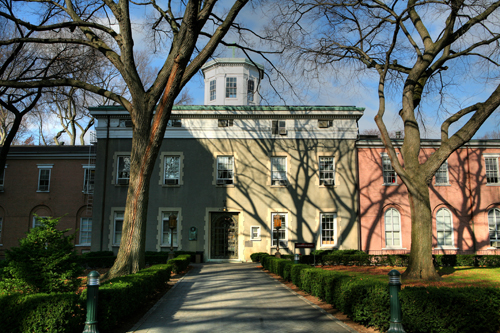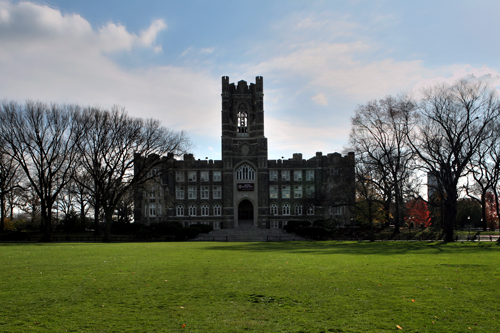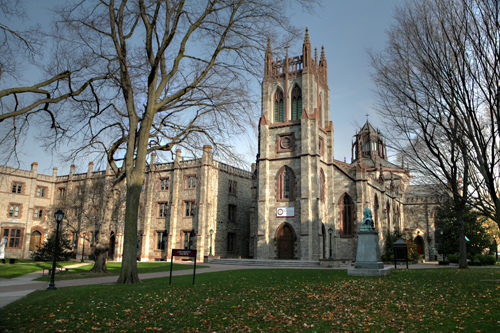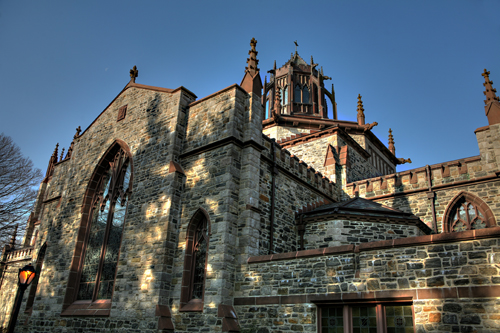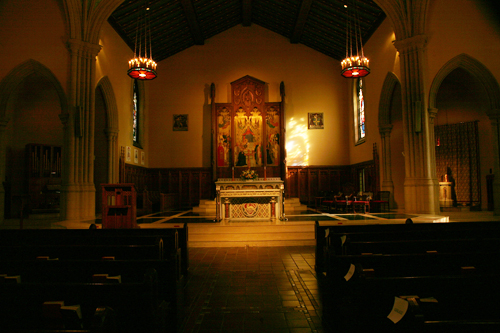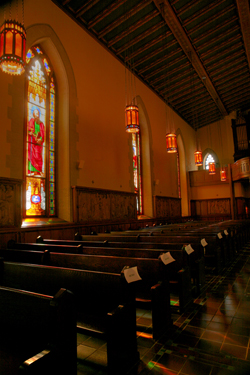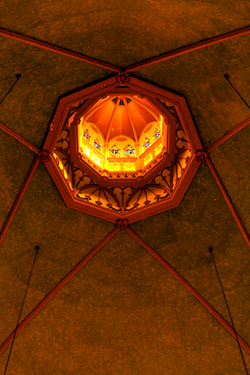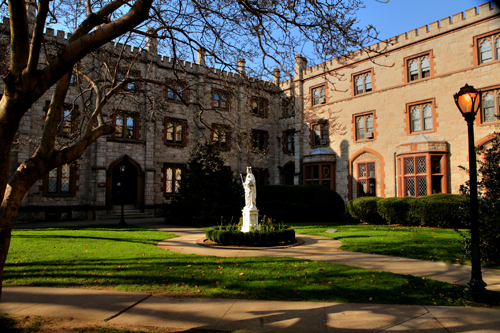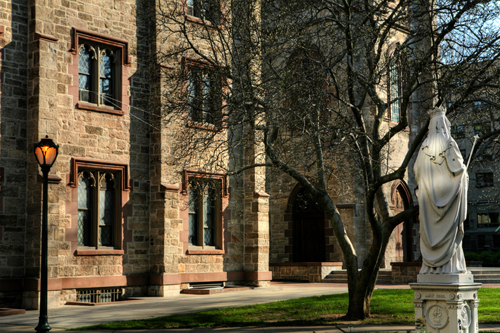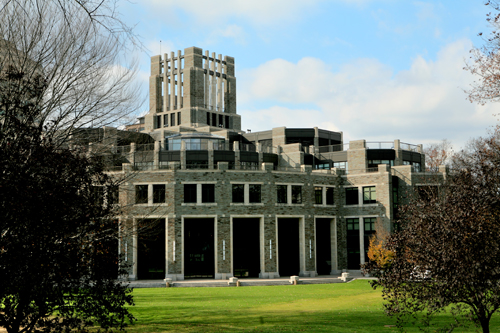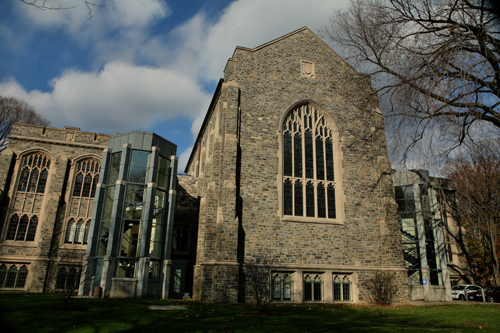Fordham University
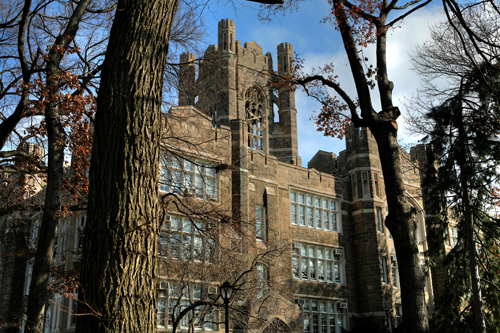
Fordham Road between Webster Avenue and Kazimiroff Boulevard
Rose Hill (now Administration Building), 1836-38; Alumni House, 1840; University Church (formerly St. John’s Church), 1845, William Roderigue; St. John’s Hall. ca. 1845, William Roderigue
In 1839 Roman Catholic Bishop John Hughes, acting for the New York diocese, bought “Rose Hill,” an estate in the former manor of Fordham, planning to use it as the seat of a Roman Catholic seminary and college. St. John’s opened its doors (to six students) in June, 1841.
Hughes’s brother-in-law, William Roderigue, served St. John’s as lay instructor in mathematics and engineering. Roderigue, by profession an architect, would a decade later be assisting James Renwick Jr. in the neo-medieval design of New York’s St. Patrick’s Cathedral. In the 1840s, he was faced with the task of converting a Greek Revival campus to an appropriately Gothic style.
Rose Hill’s manor house (today’s Administration Building), built in 1836, doesn’t look like anything in classical Greece. Ignoring the wings which have been added, we find it a rectangular building of irregular fieldstone, with two stories of evenly spaced, large double-hung windows, an attic story of smaller rectangular lights, a cornice, and an octagonal cupola set on a nearly flat roof. The planarity and balance are pleasing, but the “Grecian” note lies only in the details. Oversize stone lintels bear formalized carved palmettes. There are dentils on the underside of the cornice and the roof of the cupola. Most notable is the central marble doorway ensemble, which might have been lifted directly from Washington Square North. At the head of a short flight of steps, elegantly thin (even emaciated) fluted ionic columns, alongside square pillars with engaged pilasters behind, support a thick entablature. Above it is a window with narrow sidelights in a stone enframement, capped by a pointed lintel. A visitor who looks inside the main doorway will find a passage terminating in flanking columns whose elegant capitals uphold an architrave, hallmark of the Greek Revival interior.
Another, smaller building at Rose Hill, now the Alumni House, looks rather like the “pill box” it was named by students when it served as the college’s infirmary. But still there are emphatic ornamental touches: sidelights and pilasters at the doorway, a wood attic story under a cornice, keyed lintels, and a flight of steps with an iron balustrade. Bearing the date of 1840 over its door, this may nevertheless be an outbuilding of the original estate fitted out to house students or faculty while the new seminary building was being prepared.
That building, St. John’s Hall (1845), is where architect Roderigue tried his hand at the Gothic Revival style. Like its “Greek” predecessor, early Victorian Gothic was often a matter of picturesque detail rather than fundamental structure. The seminary building is a three-story rectangular box to which medieval accessories have been applied--but with extreme delicacy. Buttresses rising to turrets divide the facade into seven bays. The irregularly coursed rough ashlar of the walls contrasts with a smooth brown stone that organizes the horizontals of the facade, the brown capstones of the buttresses being placed at the levels of the brown window label-moldings, for example. From the same attractive stone are carved the cusped enframements of paired diamond-pane windows, as well as the central ogival doorway. The original hall is beautifully preserved, and even after having been joined (in 1940) by two other buildings in a closely imitative style, maintains its uniqueness in the resultant Queen’s Court.
Adjoining the hall, Roderigue built a small chapel for the seminarians. St. John’s (now University Church) carries over the surface details of its neighbor, using the same brown stone on its stringcourses, hood-moldings, and enframements, as well as on the finials along its nave roof. (That roof has a crenellated parapet, matching the one on the hall.) The main feature of the original church is its frontal square-plan tower, in English Decorated style. The pointed-arch of the entry is repeated in a quoined window-frame above, with an oculus in the third story, where presumably first hung the bell which disturbed the sleep and inspired the poetry of Edgar Allan Poe, who lived a short distance away.
Today that same bell (“Old Edgar”) has been moved to a higher pinnacled belfry, which replaces Roderigue’s original steeple. In fact, much of the present church is made up of later additions to the 1845 structure, including the spectacular octagonal crossing, crowned with a copper version of the lantern of England’s Ely Cathedral. An important exception is the set of Sèvres stained-glass windows along the nave, a gift of France’s Louis-Napoleon.
In 1846, with the arrival of Kentucky Jesuits led by Father Thebaud, the seminary was displaced, and St. John’s became a degree-granting institution, in 1907 renamed Fordham University. Following Roderigue’s Gothic invasion, the campus has undergone successive waves of architectural medievalisation, often in a predictable “Collegiate Gothic” manner.
David Bady
Photographs:
Tom Stoelker
